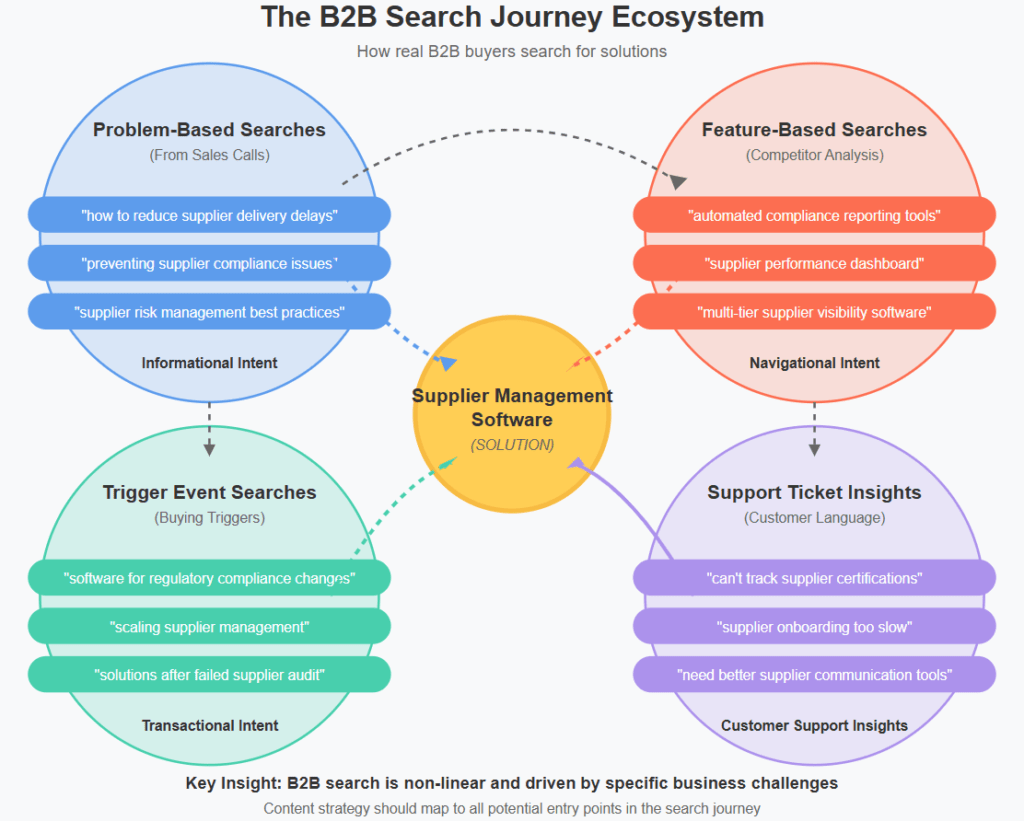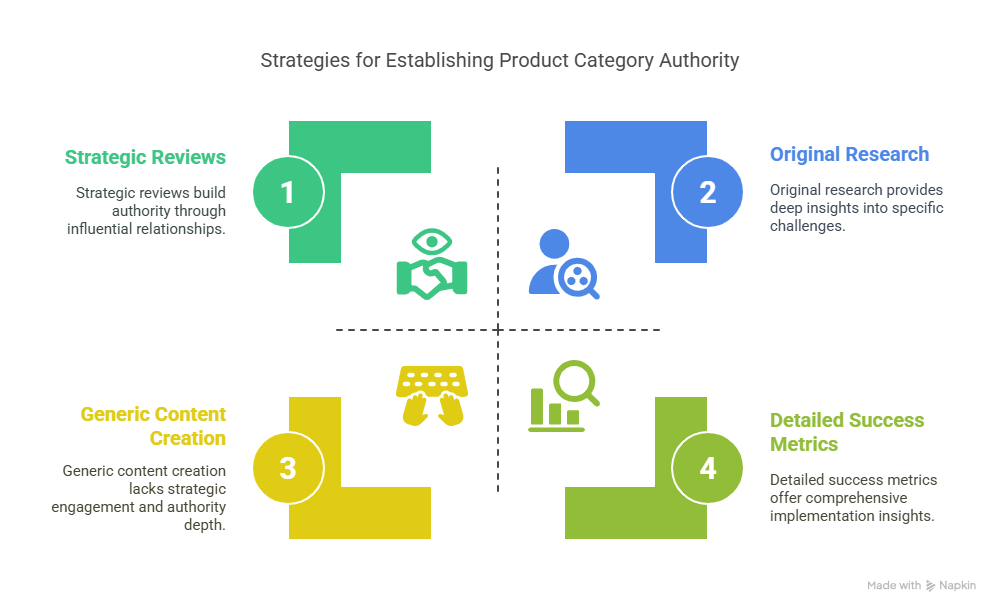Want to know the biggest mistake I see in B2B SEO? Trying to rank for everything. I’ve discovered that the foundation of any successful B2B SEO campaign isn’t about keywords or technical optimizations, it’s about truly understanding your product’s role in your customer’s business. When you deeply grasp why a CFO stays awake at night worrying about their current solution, or what drives a Director of Operations to finally seek a better way, you can create content that genuinely resonates. Let me share exactly how you can create a winning B2B SEO campaign by taking this focused approach.

Define Your Product’s Search Landscape
I can’t tell you how many times I’ve seen B2B companies jump straight into keyword research without first understanding how their customers actually search for solutions. Here’s the thing: B2B buyers rarely start with product-specific searches. Instead, they begin by looking for answers to their problems.
Let me walk you through my process for mapping out a product’s true search landscape:
Start with Sales Calls: There are so many insights to be gained by reviewing your sales team’s call recordings. I make it a point to listen to at least 20 discovery calls when starting a new B2B SEO campaign. Pay attention to the specific language prospects use when describing their challenges. Think about it this way: procurement managers typically don’t start by searching for “supplier management software”, they’re searching for solutions to immediate problems like “how to reduce supplier delivery delays” or “preventing supplier compliance issues.” The software is the solution, but the pain point is what drives the search.
Monitor Support Tickets: Your customer support tickets are another treasure trove of natural language. These show you exactly how existing customers describe problems with their current solutions. I’ve found that these queries often become the basis for highly effective middle-of-funnel content that addresses specific pain points.
Analyze Competitor Positioning: Don’t just look at what keywords your competitors rank for, analyze how they position their solutions. What problems do they claim to solve? What features do they emphasize? More importantly, what are they missing? I always create a gap analysis spreadsheet that maps competitor rankings against specific product features and pain points.
Document Buying Triggers: Understanding what finally pushes a prospect to search for a solution is crucial. Through customer interviews, I’ve identified common triggers like:
- Regulatory changes that make manual processes too risky
- Growth that makes current solutions unsustainable
- Failed audits that expose system weaknesses
- New leadership wanting better visibility
Map the Full Journey: Create a search journey map that outlines different paths customers might take. For instance, a searcher might start with “compliance reporting challenges,” move to “automated compliance reporting solutions,” and finally look for specific products. Your content needs to capture them at each stage.
Search Intent Analysis: For each major search term, analyze the current ranking content to understand search intent. I use a simple framework:
- What specific problem is the searcher trying to solve?
- What stage of the buying journey are they in?
- What format of content is currently ranking?
- What questions are left unanswered by current results?
The key is to go beyond traditional keyword research and truly understand the ecosystem of searches that surround your product. This deeper understanding will inform everything from your site structure to your content strategy.

Build Your Product-Focused Keyword Strategy
Keyword strategy isn’t about volume, it’s about capturing the right searches at the right time. Let me break down how to build a keyword strategy that actually drives qualified leads.
Start with Feature-Specific Terms: The trick here is to think in layers. Take a manufacturing automation platform, for example. Instead of targeting broad terms like “manufacturing software,” you want to focus on specific feature searches that indicate a real need:
- “Real-time production monitoring software”
- “Automated quality control systems”
- “Machine downtime tracking solution”
These searches might have lower volume, but they come from buyers who know exactly what they need.
Integration and Compatibility Searches: Here’s something many B2B companies miss, integration-related searches often indicate a serious buyer. When someone searches for “ERP integration with Salesforce” or “automation platform compatible with SAP,” they’re usually already using enterprise software and have budget authority. Build out keyword clusters around:
- Integration capabilities
- Platform compatibility
- API documentation
- Data migration
Pain Point-to-Feature Mapping: This is where understanding your product deeply pays off. Create a matrix that maps specific industry pain points to your features. For instance:
- Pain point: “reduce manufacturing waste”
- Feature search: “predictive maintenance software”
- Solution search: “how to prevent equipment failures”
Target each pain point with multiple content types to capture different search intents.
High-Intent Purchase Indicators: Look for keyword modifiers that signal purchase intent:
- Implementation terms (“deployment,” “setup,” “integration”)
- Comparison terms (“vs,” “alternatives,” “comparison”)
- Pricing terms (“cost,” “pricing,” “ROI”)
- Social proof terms (“reviews,” “case studies,” “testimonials”)
These might not have huge search volume, but they have the best conversion rates.
Geographic and Industry Variants: Don’t forget to consider industry-specific terminology and geographic variations. A “warehouse management system” might be called “logistics software” in some regions, or “inventory control system” in others. Build out keyword clusters for each major industry and region you serve.
The key is to organize these keywords into clear topic clusters that align with your product’s features and your customers’ buying journey. This isn’t about casting a wide net, it’s about setting precise traps for qualified leads.

Remember, the best keyword strategy evolves. Set up regular check-ins with your sales team to understand new pain points and features that customers are asking about. Your keyword strategy should grow with your product.
Create Solution-Specific Content That Converts
The biggest mistake I see in B2B content? Generic feature lists that could apply to any competitor. Let me show you how to create content that actually demonstrates your product’s unique value and drives conversions.
Deep-Dive Comparison Pages: Stop creating basic comparison tables. Instead, build comprehensive comparison pages that own the conversation. When creating comparison content:
- Focus on specific use cases rather than feature checklists
- Include real implementation scenarios
- Discuss integration capabilities in depth
- Address migration concerns
- Compare total cost of ownership, not just pricing
For example, if you’re selling analytics software, don’t just list that you have “advanced reporting”, break down exactly how your reporting handles complex scenarios that your competitors can’t match.
Feature-Focused Landing Pages: Your feature pages need to do more than describe functionality. Each page should:
- Open with the specific problem this feature solves
- Include technical specifications for IT stakeholders
- Provide implementation examples
- Show ROI calculations
- Feature customer quotes specific to this capability
A great feature page anticipates and answers every question a technical evaluator might have while still speaking to business value.
Technical Documentation That Ranks: Here’s a secret, well-written technical documentation can drive valuable organic search traffic. But it needs to be structured correctly:
- Create clear hierarchies for different user levels
- Include practical examples and use cases
- Add troubleshooting sections that address common issues
- Make it accessible to both technical and non-technical readers
- Include clear next steps for implementation
Remember, technical content often captures buyers who are already using a competitor and searching for specific functionality.
ROI-Focused Case Studies: Transform your case studies from success stories into conversion tools:
- Lead with specific metrics and results
- Break down the implementation process
- Include actual timelines and resource requirements
- Address common objections that came up
- Detail integration challenges and solutions
- Provide concrete ROI calculations
The best-case studies give prospects a clear picture of what their own implementation journey would look like.

Bottom line: every piece of content should demonstrate deep expertise in your specific solution space. Don’t try to be everything to everyone, be the definitive source for your specific product category.
Pro tip: Create content templates for each of these types that your team can follow. This ensures consistency in how you present technical details while maintaining your unique value proposition throughout.
Optimize Technical Elements for Product Discovery
Listen, I know technical SEO can feel overwhelming, but here’s the truth: for B2B product pages, you don’t need to implement every possible optimization. You need to nail the elements that actually impact product discovery and conversion. Let me break down what really matters.

Schema Markup That Sells: I see too many B2B sites using basic Article schema when they should be leveraging more specific types. For product pages, you want to implement:
- Product schema with all technical specifications
- SoftwareApplication schema for tech products
- FAQPage schema for support sections
- HowTo schema for implementation guides
The goal isn’t just to get rich snippets or be seen in AI overviews, it’s to help search engines understand exactly what your product does and who it’s for.
Site Architecture for Complex Products: Your site structure needs to support both SEO and the buyer’s journey. Here’s what works:
- Create clear product category hierarchies
- Build topical clusters around each major feature
- Link related features and solutions naturally
- Maintain shallow click depth to important pages
The key is making your product architecture intuitive to both search engines and users. Each feature or solution should be easily discoverable through multiple logical paths.
Conversion Tracking Setup: You can’t optimize what you don’t measure. Set up detailed tracking for:
- Product demo requests
- Trial signups
- Feature-specific page engagement
- Technical documentation downloads
- Pricing page interactions
Pro tip: Set up separate conversion paths for technical evaluators versus business decision-makers. They often take different routes to conversion.
Mobile Optimization for B2B: Here’s something many miss, while your B2B buyers might convert on desktop, they often do initial research on mobile. Focus on:
- Making technical specifications easily scannable
- Ensuring pricing tables are mobile-friendly
- Optimizing forms for mobile completion
- Creating collapsible technical documentation
- Maintaining fast load times for spec sheets
Remember, a poor mobile experience can knock you out of consideration before the buyer ever reaches their desktop.
Page Speed for Product Pages: Product pages often get bloated with features, screenshots, and interactive elements. Optimize by:
- Lazy loading images below the fold
- Minifying product demonstration videos
- Using proper image formats and sizes
- Implementing efficient caching
- Optimizing third-party scripts
The goal is to deliver a fast, smooth experience without sacrificing the detail B2B buyers need to make decisions.
Don’t let anyone tell you technical SEO isn’t important for B2B. It absolutely is, but it needs to be focused on elements that actually impact product discovery and conversion. Effective technical SEO ensures that your website is optimized for search engines, enabling potential clients to easily find your products or services. Among various strategies, adhering to cms migration best practices is crucial, as a smooth transition can significantly enhance user experience and maintain your site’s SEO equity. By focusing on these key elements, you can drive better traffic, increase engagement, and ultimately improve conversion rates, ensuring that your B2B business thrives in a competitive market.
Establish Product Category Authority
Building true authority in your product category isn’t about spamming backlinks or churning out generic content. After years of SEO campaigns, I’ve learned that category authority comes from becoming the go-to source for specific solutions. Here’s how to make that happen.
Secure Strategic Reviews: Forget mass outreach for generic reviews. Instead, focus on building relationships with sources that actually influence B2B buying decisions:
- Industry analyst firms (beyond just Gartner and Forrester)
- Professional associations in your target verticals
- Technical review platforms that specialize in your category
- Industry-specific publications that your buyers trust
The goal isn’t just getting mentioned, it’s being included in the conversations that shape purchase decisions in your space.
Create Original Research: Nothing builds authority like original insights. But here’s the key, focus your research on specific challenges within your product category. For example:
- Survey IT decision-makers about specific integration challenges
- Analyze anonymized product usage data to reveal industry trends
- Study implementation timelines and success factors
- Research the cost impact of specific technical problems
Then package these insights into compelling content that demonstrates your deep understanding of the space.
Build Strategic Content Partnerships: Look for partners who complement your solution:
- Integration partners who can validate your compatibility
- Industry experts who can verify your technical capabilities
- Academic institutions researching related technologies
- Professional organizations focusing on your solution space
The best partnerships aren’t just about links, they’re about creating valuable resources that showcase your expertise.
Generate Detailed Success Metrics: Move beyond basic case studies. Create detailed documentation of customer success that includes:
- Specific implementation challenges and solutions
- Real performance metrics pre and post-implementation
- Technical details about integration and deployment
- Actual ROI calculations with methodology
- Long-term impact assessments
Pro tip: Create success metric templates that your customer success team can easily populate with new wins.

The secret to category authority isn’t trying to be the biggest voice, it’s being the most credible voice for your specific solution. Focus on demonstrating deep expertise in your particular niche, and the authority will follow naturally.
Remember: Authority building is a long-term game. Don’t get discouraged if it takes time to see results. Keep focusing on creating valuable, specific content and building genuine relationships in your space.
The secret to a winning B2B SEO campaign isn’t casting a wide net, it’s becoming the dominant force for your specific solution. By focusing your SEO efforts on individual products and their unique value propositions, you’ll create more relevant content, attract more qualified leads, and see faster results. Start by picking your most promising product, apply these strategies, and transform your SEO from generic to generating real leads.
I’m an SEO and performance marketing leader who loves breaking down complex strategies into clear, actionable insights. I have driven growth for reputable brands such as SAP, Four Seasons, BioMarin Pharmaceutical, and Rosewood Hotels in SEO and Performance Marketing strategy.

